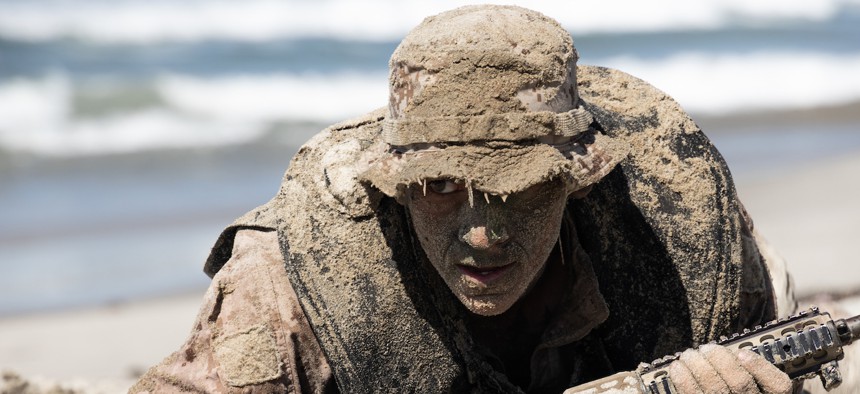
A scout swimmer with 1st Battalion, 5th Marines, I Marine Expeditionary Force, low crawls during a boat raid course at Red Beach, Camp Pendleton, California, Sept. 22, 2021. U.S. Marine Corps photo by Cpl. Brandon Salas
Marines Look To A Future Where More Authority, Intel Moves to the Edge
Commandant sees empowered battlefield commanders, and new support roles further from the front lines.
Marine commanders on the battlefield need access to better intelligence and AI tools for more rapid decision making, while higher-ranking commanders further from the tactical edge must accept that their picture may be less timely and complete and will focus more on pre-planning logistics, Marine Corps Commandant Gen. David Berger said Thursday.
Speaking at a Hudson Institute event, Berger laid out his thoughts on how the Marine Corps must continue to transform to prepare for future potential fights against highly advanced adversaries like China and Russia.
First, the Corps and the military must recognize that in highly contested environments with an advanced adversary, the Marine Corps will play a different role than it did during U.S. operations in the Middle East, and must be positioned forward before conflict starts, he said.
“In a very simple sense, the way that I view it is: The most forward parts of the U.S. military in a contested environment, before shots are fired, are going to be special operations units, submarines, and Marines” Berger said. “If those three are forward persistently before, how do we stitch them together into some sort of framework where they can move information? Where they can—with some overlap, but not too much redundancy—cover the playing field?”
Berger said that over the last six months, the Marine Corps has spent a lot of time working on creating a better, more networked intelligence-sharing concept between those three elements. “We’ve been going 100 miles an hour to sort through how to do that. It's not as simple as: create a joint task force that all three of you all work for.”
One of the biggest challenges will be empowering commanders closer to the front lines not only with better intelligence but also new AI software tools to advise and suggest courses of action, similar to how a staff of junior officers and analysts might advise a commander.
The roles of higher-ranking officers further from the fight will also shift, Berger said. For starters, logistics must cease to be an afterthought. “Intelligence [used] to drive operations. And it should. But now, like, bring the logistics into the conversation in the first paragraph… I think everything from pre-positioning ashore to pre-positioning afloat to the lift… We're going to need to think about it going forward.”
In future environments where an adversary like China or Russia will do all it can to disrupt the flow of information, commanders further from the action will need to understand that they won’t just be able to turn on screens to survey the entire battlespace as easily as they could for Iraq, Afghanistan or other so-called permissive intelligence collection environments, he said.
“Many of them [commanders] grew up the last 20-25 years where [headquarters] would have had nothing but plasma screens that gave us a picture of every square inch of territory we wanted to stare at 24/7. We got comfortable… making decisions off of that. That's not how the future is going to be.”




